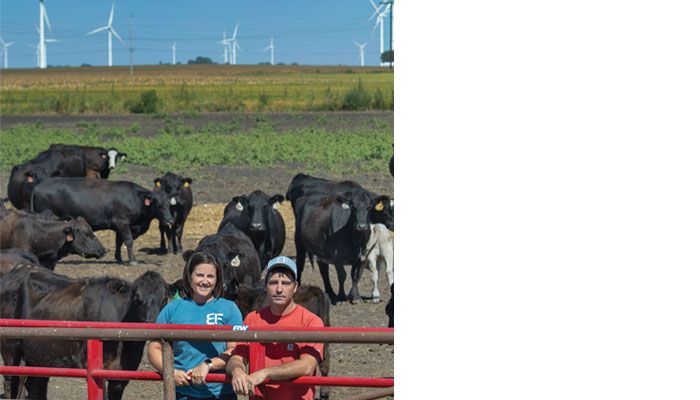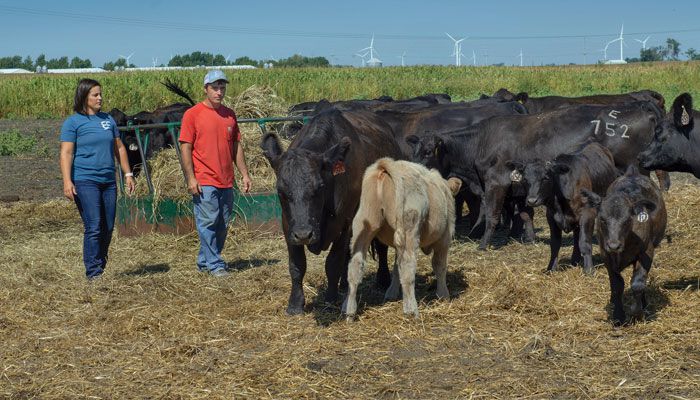We all want to know that our food was raised sustainably, with minimal impact on the environment and a focus on quality animal care. For Iowa farmers, sustainability is also a top priority.
As a mom, Kellie Blair says she understands why consumers today are more focused on sustainability and how their food choices impact our climate and the environment.
And as an Iowa cattle farmer, Blair says she listens to what her customers want. She and her husband, AJ, have made conservation and sustainability a priority on their farm.
“I’m the main consumer for my family. I am the one who goes to the grocery store. And I can totally see why (sustainability) is a concern,” says Blair, a mother of two who farms with her husband near Dayton in central Iowa.
“When you go to the store and look at packaging and labels, there is a lot to think about,” she adds. “And it makes you think that the responsibility is on you to buy the products that are going to help the Earth.”
Blair says her family is always looking to adopt new technology and animal care practices that help further reduce their farm’s impact on the environment.

(Photo above: Webster County Farm Bureau members Kelli and AJ Blair raise cattle and crops near Dayton. Kelli says the cattle play a key role in their farm's sustainability efforts.)
The Blairs, who are Webster County Farm Bureau members, also collect data on the farm to measure and track their progress in meeting long-term conservation goals.
“One of our mottoes is continuous improvement,” Blair says. “We always want to get better at things, whether it’s on the farm or in our personal lives.”
Cattle play an important role in helping the Blairs meet their sustainability goals, Blair explains.
The Blairs use cattle manure as a natural fertilizer for their corn and soybean crops. The cattle then consume the corn and hay that are grown on the Blairs’ farm. “We know exactly what the cattle are being fed and where that feed came from,” Blair says.
In addition, the Blairs plant cover crops on their fields in the late fall and winter. The cover crops help hold soil in place in between growing seasons and absorb nutrients to help improve water quality.
On the Blairs’ farm, the cover crops also serve as cattle feed.
“Really, the cattle help provide that sustainability piece for us. (Cover crops) work really well with our livestock,” Blair says.
“Our cows and calves over the winter are out on the crop fields. And that’s a sustainability piece because the cover crops are helping provide food for our cattle, while also putting roots down into the ground and keeping nutrients in the soil.”
Indeed, U.S. cattle farmers continue to make progress in improving sustainability.
In the last 40 years, the U.S. cattle herd has shrunk by one-third, yet U.S. farmers are producing more beef today than they did in the 1970s, according to the U.S. Department of Agriculture (USDA).
Cattle farmers are also reducing their environmental footprint. For example, total emissions of methane — a greenhouse gas — per unit of beef declined 10 percent from 1990 to 2016, shows an American Farm Bureau Federation analysis of data from the U.S. Environmental Protection Agency and the USDA.
In total, agriculture accounts for 9% of U.S. greenhouse gas emissions, reports the EPA. Of that number, livestock production contributes only 3.9% of greenhouse gas emissions.
In comparison, the use of fossil fuels is the number one human activity that generates greenhouse gases. Transportation, electric production and industry account for 80% of all greenhouse gas emissions in the United States, the EPA reports.
Even extreme dietary changes — such as switching to a vegan, all-plant diet — won’t have much impact on climate change.
Removing all livestock and poultry from the U.S. food system would only reduce global greenhouse gas emissions by 0.36 percent, according to 2018 research by the USDA and Virginia Tech.
On their farm, the Blairs use data to measure whether conservation efforts are helping to reduce their environmental footprint.
“We put a lot of value on that data and being able to look at that from year to year,” Blair says. “It excites us a lot, because as farmers, we are able to sit down and think about what goals do we have ... and what do we want it to look like.”

(Photo above: Kelli and AJ Blair feed their cattle the corn, grains and cover crops they grow on their own farm. In turn, they use the cattle manure as a natural fertilizer, helping create the sustainability cycle.)
Blair says cattle help manage the risk of trying new farming practices and increasing biodiversity on their farm.
This past growing season, the Blairs grew food-grade oats for the first time. They plan to market the crop to an oat-milk manufacturer.
If for some reason the oats don’t meet food-grade standards, then the Blairs will feed the crop to their cattle, thus preventing food waste.
Cattle are natural “upcyclers,” because the animals consume plant materials — such as grasses, corn stalks, ethanol byproducts and more — that are inedible to humans because of the animal’s unique ruminant digestive system.
Even vegetarians benefit from cattle. Cattle eat the inedible “leftovers,” such as pea pods, beet tops and wheat stalks, from the production of plant-based meat substitutes.
Testing has shown that the Blairs’ conservation efforts have succeeded in reducing nitrate levels in water leaving their farm.
The Blairs achieved this goal by adopting new technologies, such precision farming and soil testing to ensure that the right amount of nutrients are applied to a field to meet the crop’s needs.
“Now we are consciously trying to figure out how to make things work for the land and for the water and for the sustainability of soils and wildlife — as I see a pheasant just fly by outside,” Blair says during the interview. “We need to accept and acknowledge that if we aren’t doing something right, we need to step up and make it right.”

